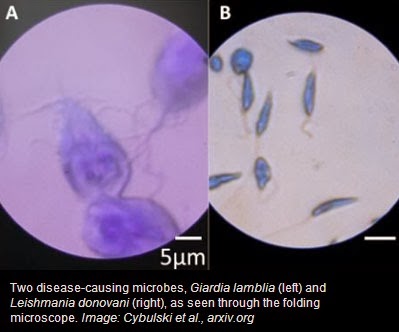Ever wanted your own microscope at home
as a kid?
Didn't want to pay too much to get one?
Well, here we are... with one you could just
make for $1!
Origami,
the Japanese art of paper folding, has evolved considerably since it appeared in the western
world over a century ago. Folding is simple, easy and cheap. So it’s no wonder that
scientists and engineers have begun to exploit it in all kinds of innovative ways. They now
use origami to construct everything from molecular machines to space
telescopes.
Prof. Manu Prakash is a Bioengineer at Stanford University in California. He and his colleagues reveal how they designed and built an origami microscope that is constructed largely out of folded paper and costs less than a dollar to make. And they say their device has the potential to change the way billions of people see the world around them.
Foldoscope is a low-cost microscope made from folded paper and a cheap lens, that could revolutionize education and health care in the developing world. A new microscope can be printed on a flat piece of paper and assembled with a few extra components in less than 10 minutes.
Their origami optics are described in a paper published on arxiv.org.
The goal, as Prakash explains in a TED talk posted today, is to provide a cheap medical screening tool that
could be widely used in the developing world. Because the microscopes can be printed by the
thousands, they could also be used for education and field research.
An outline of the parts that make up the
body of the microscope can be printed on card stock and then punched out. The additional
parts include a lens, an LED for illumination and a button battery like the ones used to
power a digital watch.
The principles of origami allow all the
optical parts to line up properly when the scope is folded together (see more about how
they’re made in the video below). Samples can be mounted to a sticky piece of tape, which
takes the place of a glass microscope slide. Depending on the lens, the scope can provide up
to 2,000X magnification, enough to see the parasites that cause malaria and other diseases.
An individual scope can be made in different configurations for different purposes. Using
certain colored LEDs for example, turns it into a fluorescent microscope capable of
visualizing specific proteins or other biomolecules labeled with fluorescent
dyes.
The microscopes can run for up to 50 hours on a single battery. They’re tough too. They can withstand being dropped or even stepped on. Eventually, of course, people are going to find ways to break their clever microscopes. But at a dollar apiece for the most expensive, high magnification version, it’s not the end of the world. Print out another sheet, fold it up, and you’re back in business.


3 comments:
Where can I purchase one of these amazing instruments?
Why does it take so long!? Erghhh! Everybody needs a foldoscope!
Post a Comment